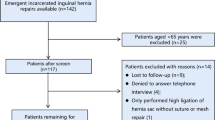Abstract
Background
Femoral hernias often present with incarceration or strangulation that requires emergency surgery. However, recommendations vary regarding optimal approaches for incarcerated femoral hernia. The aim of this study is to compare clinical efficacy between mesh repair and suture repair for the treatment of incarcerated femoral hernia.
Methods
Retrospective, single-center analysis of the clinical data from 48 patients with incarcerated femoral hernia, including 16 patients who underwent mesh repair (mesh repair group) and 32 patients who underwent traditional suture repair (suture repair group).
Results
The mean age, body mass index, incarceration duration, hernia sac size, operation duration, and the rates of postoperative incision infection, recurrence, chronic pain, and mortality were not significantly different between the suture repair and mesh repair groups (P > 0.05 for all). In contrast, the female/male ratio; the rates of bowel obstruction, coexisting diseases, and nighttime operation; and the American Society of Anesthesiologists grade were higher and the rate of prophylactic antibiotic use and the mean cost of hospitalization were lower in the suture repair group than in the mesh repair group (P < 0.05 for all).
Conclusion
The surgical approach should be chosen based on the patient’s condition. Mesh repair for the emergency treatment of incarcerated femoral hernia is safe and effective, whereas suture repair is suitable for elderly patients, those with more coexisting diseases, and those with limited life expectancy.
Similar content being viewed by others
References
HerniaSurge Group (2018) International guidelines for groin hernia management. Hernia 22:1–165
Bay-Nielsen M, Kehlet H, Strand L, Malmstrøm J, Andersen FH, Wara P, Juul P, Callesen T, Collaboration DHD (2001) Quality assessment of 26,304 herniorrhaphies in Denmark: a prospective nationwide study. Lancet 358:1124–1128
Mikkelsen T, Bay-Nielsen M, Kehlet H (2002) Risk of femoral hernia after inguinal herniorrhaphy. Br J Surg 89:486–488
Alimoglu O, Kaya B, Okan I, Dasiran F, Guzey D, Bas G, Sahin M (2006) Femoral hernia: a review of 83 cases. Hernia 10:70–73
Dahlstrand U, Wollert S, Nordin P, Sandblom G, Gunnarsson U (2009) Emergency femoral hernia repair: a study based on a national register. Ann Surg 249:672–676
Jiang XM, Sun RX, Huang WH, Yu JP (2019) Midline preperitoneal repair for incarcerated and strangulated femoral hernia. Hernia 23:323–328
Aranovich D, Zilbermints V, Kaminsky O (2018) Incarcerated femoral hernia repair with Ventralex™ hernia patch through same skin incision and suprainguinal laparotomy. Case Rep Surg 2018:9719310
Lin YT, Weng TY, Tam KW (2020) Effectiveness and safety of mesh repair for incarcerated or strangulated hernias: a systematic review and meta-analysis. World J Surg 44:2176–2184
Duan SJ, Qiu SB, Ding NY, Liu HS, Zhang NS, Wei YT (2018) Prosthetic mesh repair in the emergency management of acutely strangulated groin hernias with Grade I bowel necrosis: a rational choice. Am Surg 84:215–219
Tomaoglu K, Okmen H (2021) Prosthetic mesh hernioplasty versus primary repair in incarcerated and strangulated groin and abdominal wall hernias with or without organ resection. Retrospective study. Langenbecks Arch Surg 406:1651–1657
Ninomiya S, Fujita S, Ogawa T, Ueda Y, Shiraishi N, Inomata M, Shimoda K (2020) Incarcerated femoral hernia treated with elective totally extraperitoneal repair: a case report. J Surg Case Rep 2020:rjaa158
Kim G, Yan So JBY, Shabbir A (2017) Totally extra-peritoneal repair for acute incarcerated femoral hernia with intestinal obstruction. Int J Surg Case Rep 32:16–18
Pillay Y (2015) Laparoscopic repair of an incarcerated femoral hernia. Int J Surg Case Rep 17:85–88
Glassow F (1985) Femoral hernia. Review of 2,105 repairs in a 17 year period. Am J Surg 150:353–356
Naude GP, Ocon S, Bongard F (1997) Femoral hernia: the dire consequences of a missed diagnosis. Am J Emerg Med 15:680–682
Jones RA (1966) Femoral hernia following inguinal hernioplasty. Am Surg 32:725–732
Okazaki R, Poudel S, Hane Y, Saito T, Muto J, Syoji Y, Hase R, Senmaru N, Hirano S (2021) Laparoscopic approach as a safe and effective option for incarcerated femoral hernias. Asian J Endosc Surg 15:328–334
Bittner RR, Felix EL (2021) History of inguinal hernia repair, laparoendoscopic techniques, implementation in surgical praxis, and future perspectives: considerations of two pioneers. Int J Abdom Wall Hernia Surg 4:133–155
Tsuchiya Y, Momose H, Kure K, Ro H, Takahashi R, Okazawa Y, Kawai M, Takahashi M, Kojima Y, Sakamoto K (2021) Case of incarcerated femoral hernia treated with laparoscopic surgery after groin hernia repair. Case Rep Gastroenterol 15:35–40
Bittner JG (2016) Incarcerated/strangulated hernia: open or laparoscopic? Adv Surg 50:67–78
Funding
The study was funded by the Hangzhou medical health science and technology project (Code: B20210057).
Author information
Authors and Affiliations
Corresponding authors
Ethics declarations
Disclosures
Jianfang Li, Changfu Qin, and Yueming Hu declared that they have no conflicts of interest or financial ties to disclose.
Additional information
Publisher's Note
Springer Nature remains neutral with regard to jurisdictional claims in published maps and institutional affiliations.
Rights and permissions
Springer Nature or its licensor holds exclusive rights to this article under a publishing agreement with the author(s) or other rightsholder(s); author self-archiving of the accepted manuscript version of this article is solely governed by the terms of such publishing agreement and applicable law.
About this article
Cite this article
Li, J., Qin, C. & Hu, Y. Comparison of mesh repair and suture repair for the treatment of incarcerated femoral hernia: a retrospective, single-center study. Surg Endosc 37, 466–470 (2023). https://doi.org/10.1007/s00464-022-09488-0
Received:
Accepted:
Published:
Issue Date:
DOI: https://doi.org/10.1007/s00464-022-09488-0




